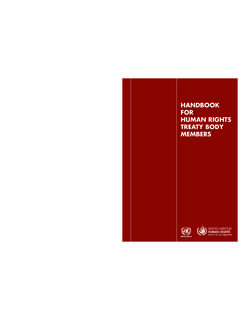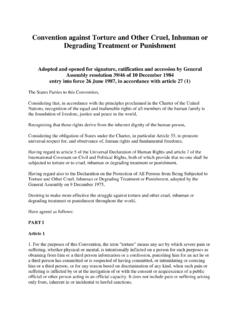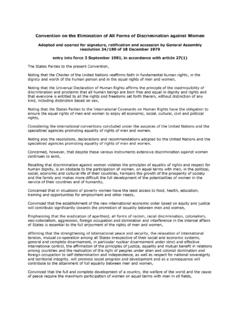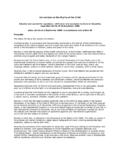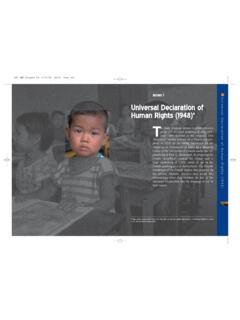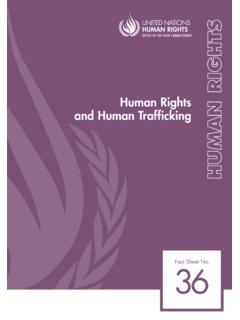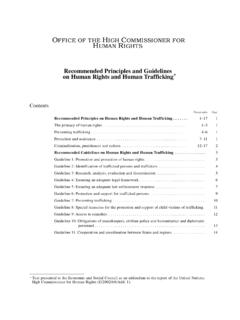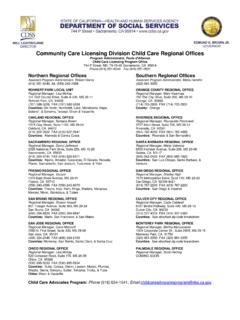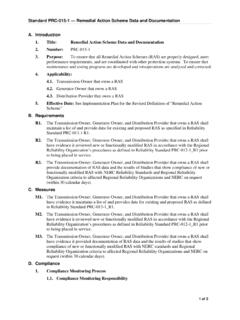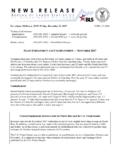Transcription of Chapter 3 THE MAJOR REGIONAL HUMAN RIGHTS …
1 Chapter 3. THE MAJOR REGIONAL . HUMAN RIGHTS . instruments AND THE. mechanisms FOR their . Learning Objectives l To familiarize participants with the MAJOR REGIONAL HUMAN RIGHTS instruments and their different modes of implementation ;. l To provide a basic understanding of how these legal resources can be used by legal practitioners, principally at the domestic level but also to some extent at the REGIONAL level, for the purpose of bringing complaints before the monitoring organs. Questions l Have you, in the exercise of your professional activities as judges, prosecutors or lawyers, ever been faced with an accused person, defendant, respondent or client alleging violations of his or her RIGHTS under REGIONAL HUMAN RIGHTS law?
2 L If so, how did you respond? l Were you aware that REGIONAL law for the protection of HUMAN RIGHTS could provide guidance for solving the problem concerned? l Were you aware that the alleged victim might ultimately bring his or her grievances to the attention of the REGIONAL commissions or courts? l If not, would such an awareness have changed your manner of responding to the alleged violations of his or her HUMAN RIGHTS ? l Have you ever brought a case against your country, or some other country, before a REGIONAL organ on behalf of an alleged victim of a HUMAN RIGHTS violation? l If so, what was the outcome of the case? l What was your experience generally of making such a complaint?
3 L Have you any experience of both the universal and REGIONAL systems? If so, what differences did you perceive? HUMAN RIGHTS in the Administration of Justice: A Manual on HUMAN RIGHTS for Judges, Prosecutors and Lawyers 71. Chapter 3 The MAJOR REGIONAL HUMAN RIGHTS instruments and the mechanisms for their implementation 1. Introduction Beginning with the adoption of the European Convention on HUMAN RIGHTS in 1950, the trend to elaborate REGIONAL standards continued with the adoption of the American Convention on HUMAN RIGHTS in 1967, which was subsequently followed by the African Charter on HUMAN and Peoples' RIGHTS , adopted in 1981. Various other REGIONAL treaties have been elaborated in an effort to render the protection not only of civil and political RIGHTS , but also of economic, social and cultural RIGHTS , more efficient.
4 In this Chapter a presentation will be given of some of the MAJOR REGIONAL HUMAN RIGHTS treaties existing in Africa, the Americas and Europe. However, given that these systems for the protection of the HUMAN person have been dealt with in depth elsewhere, the present Manual will limit itself to describing their MAJOR features. 2. African HUMAN RIGHTS Treaties and their implementation The African Charter on HUMAN and Peoples'. RIGHTS , 1981. The adoption of the African Charter on HUMAN and Peoples' RIGHTS in 1981. was the beginning of a new era in the field of HUMAN RIGHTS in It entered into force on 21 October 1986, and as of 29 April 2002 had 53 States parties. Although strongly inspired by the Universal Declaration of HUMAN RIGHTS , the two International Covenants on HUMAN RIGHTS and the REGIONAL HUMAN RIGHTS conventions, the African Charter reflects a high degree of specificity due in particular to the African conception of the term right and the place it accords to the responsibilities of HUMAN The Charter contains a long list of RIGHTS , covering a wide spectrum not only of civil and political RIGHTS , but also of economic, social and cultural RIGHTS .
5 The African Charter further created the African Commission on HUMAN and Peoples' RIGHTS , to promote HUMAN and peoples' RIGHTS and ensure their protection in Africa (art. 30). In 1998, the Protocol to the Charter on the Establishment of an African Court of HUMAN RIGHTS was also adopted, but, as of 30 April 2002, this Protocol had not yet entered into force, having secured only 5 of the required 15. ratifications. Lastly, work on the elaboration of an additional protocol concerning the RIGHTS of women in Africa is in progress within the framework of the African Commission on HUMAN and Peoples' RIGHTS , the Commission being assisted in this task by the Office of the United Nations High Commissioner for HUMAN 1 Fatsah Ouguergouz, La Charte africaine des droits de l'homme et des peuples Une approche juridique des droits de l'homme entre tradition et modernit (Paris, Presses Universitaires de France, 1993 (Publications de l'Institut universitaire de hautes tudes internationales, Gen ve)), p.
6 Xxv. 2 Keba Mbaye, Les droits de l'homme en Afrique (Paris, Editions A. Pedone/Commission Internationale de Juristes, 1992), p. 161. 3 See Mutoy Mubiala, Le Projet du Protocole la Charte Africaine des Droits de l'Homme et des Peuples relatif aux Droits de la Femme en Afrique , in HUMAN RIGHTS , Spring 2000 (OUNHCHR review), pp. 23-27. 72 HUMAN RIGHTS in the Administration of Justice: A Manual on HUMAN RIGHTS for Judges, Prosecutors and Lawyers Chapter 3 The MAJOR REGIONAL HUMAN RIGHTS instruments and the mechanisms for their implementation The undertakings of the States parties The States parties to the Charter shall recognize the RIGHTS , duties and freedoms enshrined [therein] and shall undertake to adopt legislative or other measures to give effect to them (art.)
7 1). It is further provided that they shall have the duty to promote and ensure through teaching, education and publication, the respect of the RIGHTS and freedoms contained in the present Charter, and to see to it that these freedoms and RIGHTS as well as corresponding obligations and duties are understood (art. 25). Moreover, the States parties shall have the duty to guarantee the independence of the Courts and shall allow the establishment and improvement of appropriate national institutions entrusted with the promotion and protection of the RIGHTS and freedoms guaranteed by the .. Charter . (art. 26). These two latter provisions thus emphasize the need for education, information and an independent administration of justice in order to ensure the effective protection of HUMAN RIGHTS .
8 Lastly, several provisions of the Charter are also couched in the form of duties of the States parties to ensure certain RIGHTS , such as, for instance, the promotion and protection of morals and traditional values recognized by the community (art. 17(3)). and the right to development (art. 22(2)). The individual and collective RIGHTS recognized The African Charter on HUMAN and Peoples' RIGHTS recognizes the following civil, political, economic, social and cultural RIGHTS of individual HUMAN beings, in particular: v the right to freedom from discrimination on any grounds in the enjoyment of the RIGHTS and freedoms guaranteed in the Charter art. 2;. v the right to equality before the law and to equal protection of the law art.
9 3;. v the right to respect for one's life and personal integrity art. 4;. v the right to respect for one's inherent dignity as a HUMAN being, including freedom from slavery, the slave trade, torture, cruel, inhuman or degrading punishment and treatment art. 5;. v the right to liberty and to the security of one's person; freedom from arbitrary arrest or detention art. 6;. v the right to have one's cause heard, and the right to an appeal to competent national organs against acts of violating one's HUMAN RIGHTS ; the right to be presumed innocent until proved guilty by a competent court or tribunal; the right to defence; and the right to be tried within a reasonable time by an impartial tribunal.
10 Freedom from ex post facto laws art. 7;. v freedom of conscience, the profession and free practice of religion art. 8;. v the right to receive information and the right to express and disseminate one's opinions within the law art. 9;. v the right to freedom of association (art. 10) and the right to assemble freely with others art. 11;. HUMAN RIGHTS in the Administration of Justice: A Manual on HUMAN RIGHTS for Judges, Prosecutors and Lawyers 73. Chapter 3 The MAJOR REGIONAL HUMAN RIGHTS instruments and the mechanisms for their implementation v the right to freedom of movement and residence within the borders of a State; the right to leave any country including one's own and to return to one's country; the right to asylum in case of persecution; prohibition of mass expulsions art.
